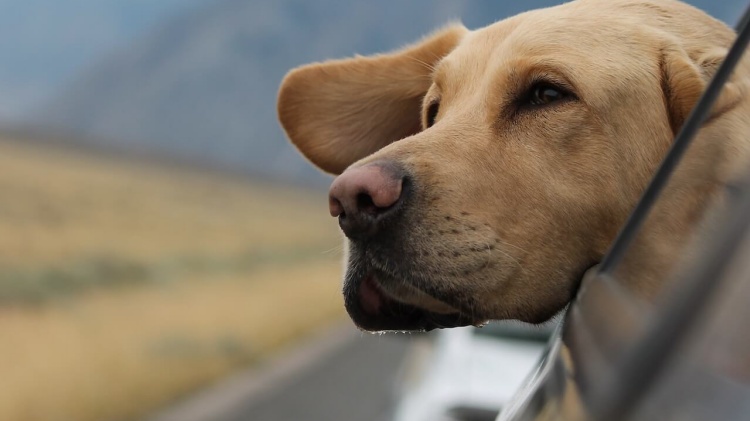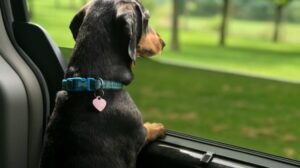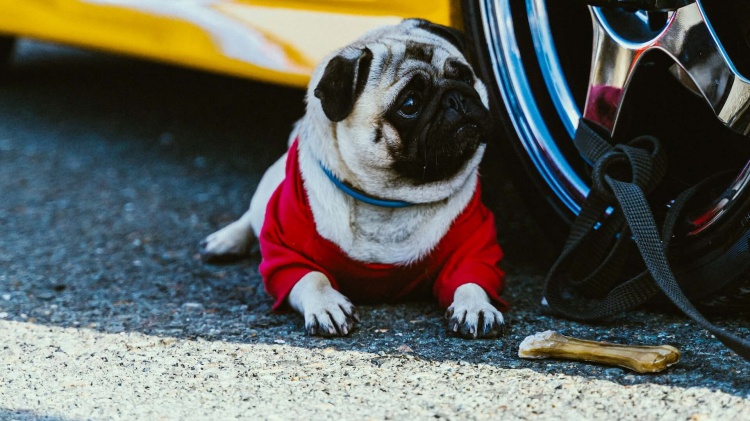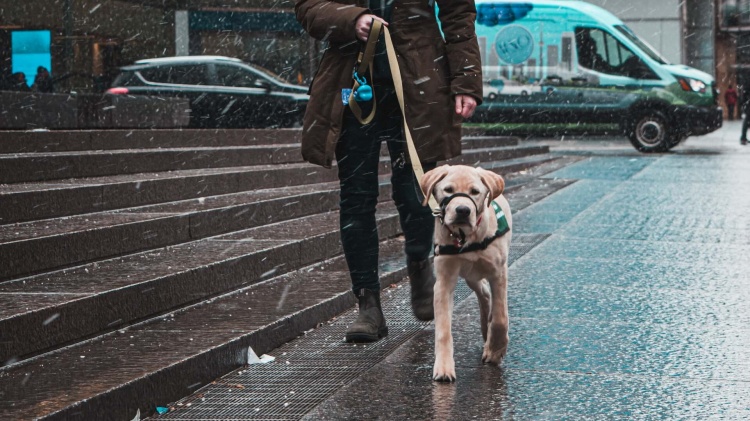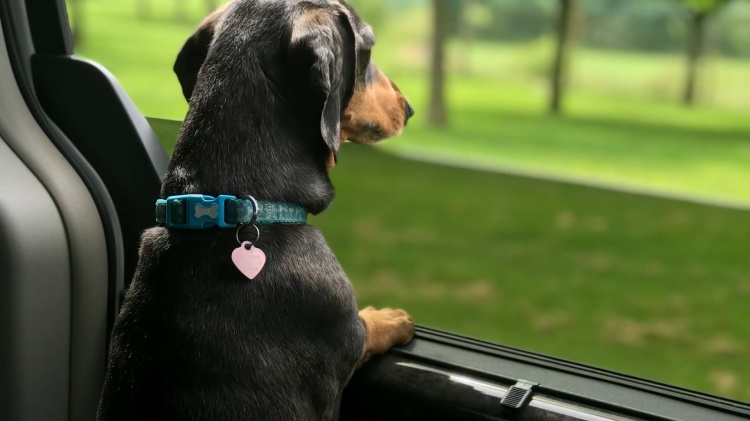Getting pets in and out of vehicles can be challenging, especially for seniors, injured, or large dogs. Dog car stairs provide a simpler, safer solution to help dogs access cars, trucks, and SUVs.
However, to ensure safe use, there are important considerations when selecting and utilizing dog stairs. This comprehensive guide covers tips for choosing the right dog stairs, proper setup, training your dog, and optimal usage recommendations.
Selecting the best dog stairs for your vehicle
Choosing a well-suited set of dog car stairs is the first step to safe use. Keep these key factors in mind when deciding which product to purchase:
Height and size
- Measure the height from the ground to your vehicle’s floor where your dog will enter.
- Choose dog stairs that are slightly shorter than this height for the easiest access.
- Consider your dog’s size – larger steps for big dogs, smaller steps for little dogs.
- Measure your dog as well, from paw to shoulder, to determine optimal step depth and width.
- Small dogs and puppies generally do best with shallow, narrow steps.
- Larger breeds need wider, deeper stairs to comfortably fit their entire paw.
- Try out temporary boxes or platforms at various heights and widths to find the ideal dimensions for your pet.
Weight capacity
- Check your dog’s weight and confirm the stairs are rated to safely hold them.
- Look for a weight capacity of at least 150 pounds for larger dogs.
- Hard plastic or steel stairs often have higher weight limits than foam varieties.
- If you have multiple dogs using the stairs, make sure the weight limit exceeds their combined weights.
- Growing puppies will increase in weight rapidly, so choose stairs that meet their adult-size needs.
Surfaces and grips
- Opt for stairs with textured, non-slip surfaces and grips to avoid slips.
- Rubberized surfaces provide more traction than hard plastics.
- Look for grooved surfaces, treads, or attached traction grips for paw stability.
- Try pressing on the surface with your own hands to test slip resistance.
- Avoid slick shiny plastic steps which can easily lead to slides and falls.
Stability features
- Select stairs with wide, supportive bases and rubberized feet for stability.
- Some models have vehicle anchors to securely attach the stairs.
- Look for handrails or sidebars for dogs to grip while climbing.
- Wider steps tend to be more stable and prevent tipping side to side.
- Reinforced steel frames offer better stability than plastic construction.
Foldability and portability
- If you’ll need to transport or store the stairs, choose folding varieties.
- Or opt for lightweight stairs for easy portability.
- Detachable stairs break into smaller pieces for storage in tight spaces.
- Make sure folding joints lock securely – test by shaking the stairs when set up.
Carefully evaluating your dog and vehicle allows you to select the safest, most optimal dog car stairs. Take precise measurements and test products for stability when making your choice.
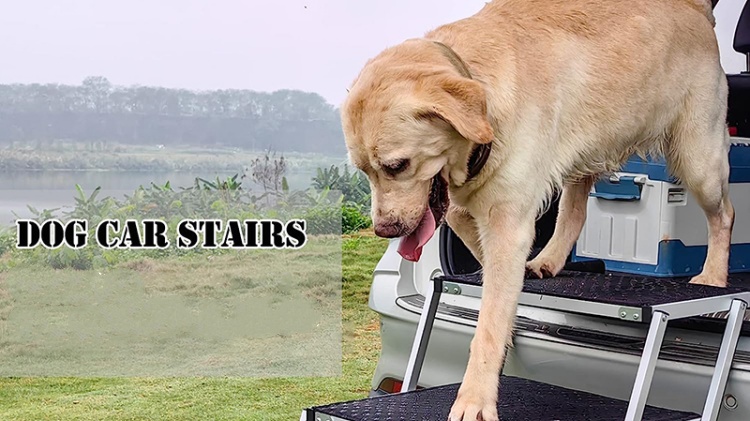
Setup tips for dog stairs
Proper setup of dog car stairs helps ensure safe usage. Follow these tips when positioning the stairs:
Vehicle positioning
- Place the stairs as close to the vehicle entry point as possible.
- There should be no gap between the stairs and vehicles.
- Maintaining 3 points of contact prevents the stairs from shifting.
- Positioning the stairs at a 90-degree angle to the vehicle improves stability.
Surface below
- Only use stairs on level, hard surfaces like pavement or wood.
- Avoid setting up on gravel, grass or uneven ground that could shift.
- Incline and decline angles add risk – always park on flat surfaces.
Anchoring the stairs
- Use anchor straps or hooks to securely attach the stairs to the vehicle.
- This prevents sliding, slipping, or separation from the vehicle.
- If your stairs don’t have anchors, use rubber cords to tie them to the vehicle.
Entry and exit angles
- Angle the stairs so your dog enters/exits straight on, not on the side.
- The ideal angle is close to 90 degrees with the vehicle for easy ascent and descent.
- Positioning the stairs parallel to the vehicle door adds instability and difficulty in turning.
With proper setup and anchoring, the dog stairs will offer optimal stability and safety. Check angles carefully and always anchor the stairs to your vehicle securely.
Training your dog on car stairs
Taking time to gradually train your dog to use car stairs is crucial for safe acclimation:
Start indoors first
- Set the dog stairs up indoors first and practice having your dog use them to reach furniture, beds, etc.
- Reward with treats for using the stairs fully. Go slowly at first.
- This gets them comfortable with the stairs in a safe, confined environment first.
Practice entering/exiting
- Place the car stairs in position by a low entry point like a bottom step.
- Practice having your dog go up and down the stairs to enter and exit. Reward and praise.
- Slowly increase the entry height with books or blocks as your dog gains confidence.
With distractions
- Have someone rattle keys or crinkle bags while your dog uses the stairs.
- Reward calm, and continued progress in the presence of distractions.
- Dogs can get startled when first using stairs in busy parking lots. Desensitize them.
Add support
- Use harnesses or straps around the belly to support and guide the dog on the stairs first.
- Have someone spot from behind to give confidence and reassurance.
- Slowly remove support as your dog demonstrates stair mastery.
Take at least 2-4 weeks to fully acclimate your dog to using the stairs properly before relying on them solely. Patience prevents accidents.
Optimizing stair safety for your dog
There are additional steps you can take to make your dog’s use of car stairs as safe as possible:
Supervise always
- Stay within arm’s reach whenever your dog uses the stairs.
- Be ready to assist or intervene if they stumble or slip.
- Dogs may get overeager and bound up steps before being fully trained. Keep them in check.
Check fit regularly
- Especially during the first month, check that the stairs don’t shift or slide as your dog uses them.
- Make sure all grips and anchors remain tightly secured.
- Periodically re-measure your dog’s size as they grow to ensure optimal stair fit.
Use harnesses and support
- Using harnesses or straps provides extra stability and support on the stairs.
- Have someone spot from behind as added assurance.
- Continue the use of harnesses and spotters until your dog demonstrates stair mastery.
Encourage slow progress
- Teach your dog to take the stairs slowly and carefully.
- Rapid running up/down should be discouraged to prevent falls.
- Practice waiting on each step before proceeding for controlled stair use.
Treat for proper technique
- Reward your dog for using the center of the stairs and all steps fully.
- Treat for careful, calm stair use to reinforce safe technique.
- If your dog tries to rush or skip steps, guide them back to go slowly.
Remaining vigilant and proactively reinforcing proper behavior will lead to excellent stair habits. Always supervise to prevent dangerous missteps.
Troubleshooting dog car stair problems
If you encounter any of these common problems, here are tips to address the issues:
A Dog is nervous about the stairs
- Introduce the stairs gradually indoors first, rewarding all interaction.
- Place treats on the stairs to encourage stepping on them.
- Use a harness for support and go extremely slowly at first.
- If they are very fearful, lift/guide them through the steps at first before having them walk.
Stairs feel unstable
- Check that the stairs are on a level surface and anchored securely.
- Ensure rubberized feet grip and all connections are tightly fastened.
- Increase stability by tying steps together with zip ties or rubber cords.
- Try a different model or brand if your dog seems insecure and ascending.
The Dog tries to take the stairs too fast
- Work on “slow” and “wait” commands when approaching the stairs.
- Leash your dog if needed to enforce a slowed pace. Praise patience.
- Use a front clip harness to physically slow the dog if needed.
Dog doesn’t use all steps
- Encourage full stair use by placing treats on each step.
- Gradually work from a few steps at a time to all steps.
- Stand at the top rewarding as your dog takes each step fully.
- Practice just 2-3 steps at a time until the process is mastered.
With troubleshooting and training, your dog should become comfortable and adept on the stairs. Never allow unsupervised use until fully trained.
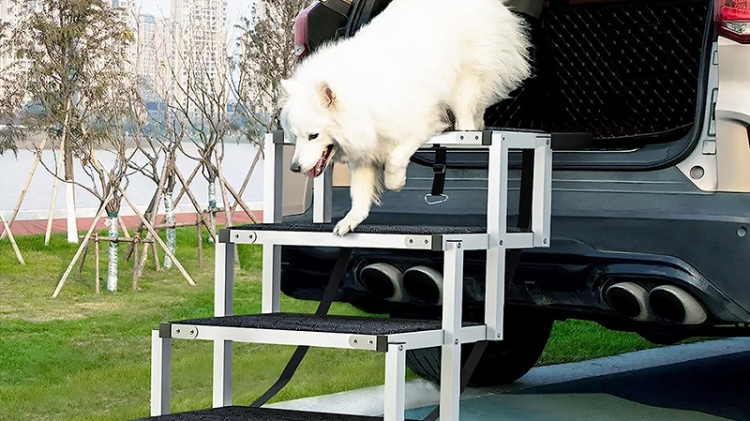
Final dog stair safety tips
Adhering to these final safety recommendations helps ensure your dog stays protected:
- Avoid slippery surfaces – only use stairs on dry, level, hard ground.
- Maintain supervision whenever your dog uses the stairs.
- Check regularly for damage and replace stairs immediately if any are noted.
- Detach and remove the stairs when not in use to prevent unsupervised access.
- Only allow one dog on the stairs at a time.
- Upgrade to larger, more reinforced stairs if there is any instability as your dog ages.
- Try out stairs in the store with your dog before purchasing it when possible.
- Have your vet ensure your dog has no conditions that could impair stair use.
- Monitor for signs of arthritis or weakness that may require stair modifications.
- Consider ramps or lifts if your dog ever appears uncomfortable on stairs.
- Never leave a dog unattended on elevated stairs.
- Use gates or doors to block access if needed when stairs are set up.
Providing sturdy, properly fitted dog car stairs that match your dog’s size and needs allows safe, stress-free access to your vehicle. Combined with training, rewards, and steady supervision, dog stairs can significantly improve your pet’s mobility and quality of life.
Follow these tips diligently for confident, safe stair use. Check-in frequently with your veterinarian as well to ensure your dog remains physically able to utilize stairs without difficulty or pain. With time, patience and the right product, stairs can be an enormous help for dogs of all ages and abilities.
Additional dog stair options
While traditional dog stairs are the most common choice, there are other products available that serve similar accessibility functions:
Dog stairlifts
- Attaches to stairs to lift dogs smoothly up steps via a sling or seat.
- Operates electronically at the touch of a button.
- Ideal for dogs with very limited mobility or paralysis.
Dog car lifts
- A platform lift raises dogs directly into vehicles.
- Also lowers dogs down, eliminating impact.
- Useful for dogs who should not use stairs at all.
Rampe per cani
- Provide a gently sloped accessible path for vehicles.
- Especially ideal for senior dogs or those with joint issues.
- Some ramps fold or telescope for transport.
- It can be used together with dog stairs for access.
Soluzioni personalizzate
- For unique vehicles, disabilities or needs, custom stairs or lifts can be designed.
- Companies like Walkin’ Pets offer personalized mobility solutions.
Carefully consider all options and seek veterinary advice on which is safest and best suited for your dog’s abilities and physical condition. With the right support, most dogs can continue enjoying rides in the car throughout their lives.
Investing in safe, comfortable dog car stairs or ramps pays dividends in preserving your dog’s quality of life as they age. With careful selection, training and use, stairs allow ongoing independence and adventures with their human companions.
Provide stability, patience and praise as your dog learns to use their new vehicle entry system. The independence and joy of riding along will be more than worth the effort.

